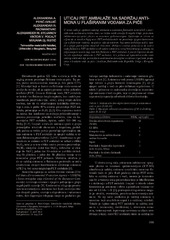Приказ основних података о документу
The influence of PET containers on antimony concentration in bottled drinking water
Uticaj PET ambalaže na sadržaj antimona u flaširanim vodama za piće
| dc.creator | Perić-Grujić, Aleksandra | |
| dc.creator | Radmanovac, Aleksandar R. | |
| dc.creator | Stojanov, Aleksander M. | |
| dc.creator | Pocajt, Viktor | |
| dc.creator | Ristić, Mirjana | |
| dc.date.accessioned | 2021-03-10T11:19:43Z | |
| dc.date.available | 2021-03-10T11:19:43Z | |
| dc.date.issued | 2010 | |
| dc.identifier.issn | 0367-598X | |
| dc.identifier.uri | http://TechnoRep.tmf.bg.ac.rs/handle/123456789/1649 | |
| dc.description.abstract | Antimony trioxide (Sb2O3) is the most frequently used catalyst in the polyethylene terephthalate (PET) manufacture. As a result, antimony is incorporated into PET bottles at concentration level of 100-300 mg/kg. PET containers are used for drinking water and beverages, as well as food packaging and in the pharmaceutical industry. Thus, it is important to understand the factors that may influence the release of antimony from the catalysts into water and other products, since antimony is potentially toxic trace element. In this paper, the antimony content in nine brands of bottled mineral and spring water from Serbia, and seven brands of bottled mineral and spring water from EU countries was analyzed. The measurements were conducted using the inductively coupled plasma-mass spectrometry (ICP-MS) technique. In the all examined samples the antimony concentration was bellow the maximum contaminant level of 5 μg/L prescribed by the Serbian and EU regulations. Comparison of the content of antimony in PET bottled waters with the content of antimony in water bottled commercially in glass and the natural content of antimony in pristine groundwaters, provides explicit evidence of antimony leaching from PET containers. Since waters bottled in PET have much greater concentration ratio of Sb to Pb than corresponding pristine groundwaters, it can be assumed that bottled waters cannot be used as the relevant source for the study of the natural antimony content in groundwaters. There is a clear relation between the quality of water in bottles (composition, ion strength) and antimony leaching rate. Moreover, while the rate of antimony leaching is slow at temperatures below 60°C, at the temperature range of 60-80°C antimony release occurs and rapidly reaches maximum contaminant level. As antimony can cause both acute and chronic health problems, factors that promote the increase of antimony concentration should be avoided. | en |
| dc.description.abstract | U ovom radu je ispitivan sadržaj antimona u uzorcima flaširanih mineralnih i izvorskih voda sa domaćeg tržišta, kao i sa tržišta nekih zemalja Evropske Unije, primenom indukovano spregnute plazme sa masenom spektrometrijom. Ispitivanja su vršena sa ciljem da se utvrdi u kojoj meri PET ambalaža utiče na povećanje njegove koncentracije u flaširanim vodama, imajući u vidu da antimon, koji sama ambalaža sadrži, spada u grupu potencijalno toksičnih elemenata. Dobijeni rezultati pokazali su da uzorci voda flaširani u PET ambalaži uvek sadrže antimon u većoj koncentraciji u odnosu na odgovarajuće uzorke koji nisu bili flaširani u PET ambalaži. I pored činjenice da dolazi do otpuštanja antimona iz PET ambalaže, ni u jednom od ispitanih uzoraka voda sadržaj antimona nije prevazilazio maksimalno dozvoljene vrednosti regulisane propisima o kvalitetu vode za piće i kvalitetu flaširanih voda Republike Srbije i Evropske Unije. | sr |
| dc.publisher | Association of Chemical Engineers of Serbia | |
| dc.relation | info:eu-repo/grantAgreement/MESTD/MPN2006-2010/142002/RS// | |
| dc.rights | openAccess | |
| dc.rights.uri | https://creativecommons.org/licenses/by-nc-nd/4.0/ | |
| dc.source | Hemijska industrija | |
| dc.subject | antimony | en |
| dc.subject | bottled water | en |
| dc.subject | PET | en |
| dc.subject | antimon | sr |
| dc.subject | flaširana voda | sr |
| dc.subject | PET | sr |
| dc.title | The influence of PET containers on antimony concentration in bottled drinking water | en |
| dc.title | Uticaj PET ambalaže na sadržaj antimona u flaširanim vodama za piće | sr |
| dc.type | article | |
| dc.rights.license | BY-NC-ND | |
| dc.citation.epage | 310 | |
| dc.citation.issue | 4 | |
| dc.citation.other | 64(4): 305-310 | |
| dc.citation.rank | M23 | |
| dc.citation.spage | 305 | |
| dc.citation.volume | 64 | |
| dc.identifier.doi | 10.2298/HEMIND100419037P | |
| dc.identifier.fulltext | http://TechnoRep.tmf.bg.ac.rs/bitstream/id/8636/0367-598X1000037P.pdf | |
| dc.identifier.scopus | 2-s2.0-77956463418 | |
| dc.identifier.wos | 000282550400006 | |
| dc.type.version | publishedVersion |

